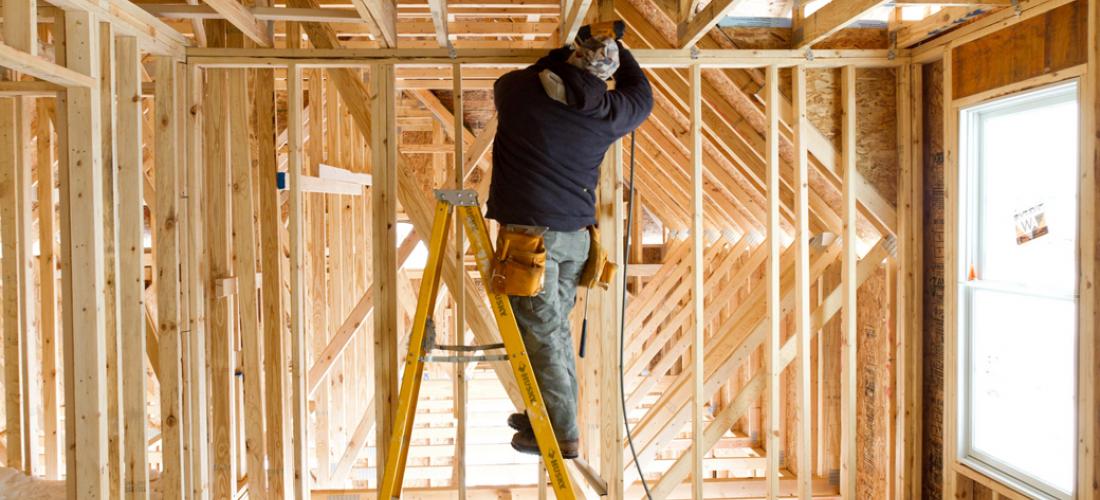

New Construction
NEW HOMES: It’s Time to Design Your Dream
A shortage of existing home inventory and the desire to “get what you want” is fueling renewed interest in new-home construction.
Southeast Wisconsin is an excellent place to build your dream home. The natural beauty of the area has lent itself to several carefully developed subdivisions that have been designed to complement existing trees, streams and other natural resources, as well as “carbon-neutral” subdivisions that feature homes equipped with solar panels to generate electricity.
New homes can be completed in as little as four to six months, with prices ranging from $300,000 to more than $1 million, depending on what you want your dream home to be. You can choose to start from scratch – choosing your own lot and then hiring an architect and/or builder to construct a home to your specifications. This is the most expensive, but potentially the most rewarding, approach.
You also can buy home-and-lot packages, which are generally more affordable, because you’re purchasing the land and the house from a single source. There are additional options here. You can choose to build from the ground up, selecting from several different floor plans provided by the builder and then choosing your own finishes. You can purchase a completed “spec” home that has already been built. Or you can choose a partially built spec home that is already framed and is ready for you to choose the interior finishes. Finally, you can build a stand-alone home that is actually a condominium – giving you all the benefits of a single-family home but without all of the tasks of lawn cutting and snow shoveling.
The Benefits of Building
The biggest advantage to building is that you can get exactly what you want. Another advantage is that everything will be new, with the latest energy-efficient technology and features. This is especially true for heating and cooling systems, water heaters, appliances, lighting, windows and skylights. You can be environmentally sustainable and save money on utility costs from the get-go, and you won’t have to worry about making costly replacements soon after you move in. You can also install green technologies such as electric car-charging stations and solar panels or prep the house so they will be less costly to install at a later date.
Modern layouts are also more conducive to current lifestyles as opposed to the way we lived a decade or two ago. Wider garages, for example, can more easily accommodate the lawn tools, bicycles, kayaks, snowmobiles, skis and other “toys” you will want to enjoy Wisconsin’s outdoors.
Finally, you can landscape your property just the way you want it, with a patio, outdoor entertainment area, shrubs and trees exactly how and where you want them.
Technology
Technology is a double-edged sword. While advances in wireless devices have eliminated the need to cable houses, the ease of installation opens up a host of new opportunities and questions concerning sound and security systems, as well as internet-enabled, remote control of your lighting, heating/cooling and appliances.
Professional Design Help
Some people shy away from home building because of the many choices involved. Selecting interior finishes, appliances, light fixtures and even door handles can seem to be overwhelming. Fortunately, many homebuilders have made the selection process easier by offering packages that provide different looks using complementary colors, fixtures and hardware that can be modified by the homeowner.
Many homebuilders also offer design services with a professional who will work with you to develop a look that fits your personality and budget.
Choosing a Homebuilder
Whether you are buying a condo, a townhouse, or building a house, you want to know that you are buying a good quality home from a reputable builder. This can be done by asking friends and colleagues or by contacting the Metropolitan Builders Association, (mbaonline.org), an organization that represents approximately 800 companies in the region.
Colleagues and online searches can provide you with a list of active homebuilders and the price ranges of the homes they build. Visit recently built homes and subdivisions. Drive by on a Saturday morning when homeowners may be outside doing chores or errands. Introduce yourself and say you are considering buying a home from the builder who built their home. Talk to several owners. The more people you talk with, the more accurate an impression of a builder you will get.
Halen Homes
Halen Homes, Milwaukee’s premier home builder is now offering luxury condominiums. Choose from single-family, twin or quad condominium homes in communities throughout Southeastern Wisconsin. At Halen Homes, you can expect well-thought-out floor plans, high-end finishes, and upscale neighborhoods. With plenty of amenities and included maintenance, carefree luxury living is waiting for you at Halen Homes.
Telephone: 414-219-0740 | Email: info@halenhomes.com | Website: HalenHomes.com
Harbor Homes
Created to provide affordable new construction in the Milwaukee area, Harbor Homes combines quality and value to make the home buying process easy, affordable, and fun. From efficient building and floor plans that maximize space to innovative technologies like Buy Now and iDesign that offer convenient, online options for buying and personalizing a new home, Harbor Homes does things differently.
Telephone: 262-232-8520 | Email: info@harborhomeswi.com | Website: HarborHomesWI.com
Purchasing Land
If you do decide to buy a lot on your own, understand that lot prices vary considerably between communities and subdivisions. It also is important to understand the legal considerations that vary between municipalities and counties.
Legal descriptions of lots are either “lot & block” or “mete & bounds.”
Lot & block parcels are the most frequently used legal description, especially within subdivisions. They state the actual lot dimensions and reference a certified survey that is kept on file at the local county courthouse.
Mete & bounds parcels are often used to describe isolated or scattered lots. If the seller uses a mete & bounds legal description, you should have your property surveyed to verify its actual boundaries.
Special Considerations
There are several issues you need to consider when choosing a lot. Due to the size of the investment you will be making and the risks involved, you should seek legal assistance and/or consult with the local building inspector before you buy. Some of the things you should consider are:
- DEED RESTRICTIONS - Ask the seller for a copy of the deed so you can review any restrictions or “covenants” that may affect the land you are buying. Some subdivisions, for instance, limit the building materials you can use to build your home, specify how your home must be placed on your lot and may require a third party to approve your home’s design. They may even prohibit you from leaving cars in the driveway. Once you have signed the deed, you are legally obligated to adhere to its restrictions.
DRAINAGE - Any purchase offer should be contingent on the parcel not being located in a floodplain and you should double check with the city engineer or building inspector. In addition, you will want to know how the lot drains and whether it is a catch basin or run off from other lots. The county surveyor’s office should have topographical maps to identify drainage patterns. - ELECTRICITY/GAS - Check with the local utilities about availability and hookup costs.
- FILL - Check with the building inspector to find out what your first-floor grade elevation will be and to determine how much fill you will have to buy or cart away from the site.
- GARBAGE - Find out whether garbage collection is included in your property taxes as a municipal service or if you will have to contract with a private company.
- SEWER/SEPTIC - If you need a septic system, make sure the lot has a recent – and acceptable – percolation and soil test. Clay soil is prevalent in Wisconsin and can interfere with drainage. If you have poor soil, you may have to install a mound-type septic system. If you have metro or storm sewer service, find out how much the lateral hookups will cost.
- WATER: Check to see whether you will need a well or will have to hook up to a community well or municipal water utility. If you have to drill a well, ask about unusual mineral content in the water. If you have a community well, ask your neighbors how it is working. If you have municipal water, find out the connection costs.
- IMPACT FEES - In an effort to control development, some communities have implemented “impact fees” that are assessed to new homes when they are built. These fees can range from $500 to more than $5,000 and are typically used to offset the cost of expanding schools and the community infrastructure to accommodate new developments. Check to see whether an impact fee has been imposed or is being considered.
Questions to Ask Your Builder
Following are questions recommended by the National Association of Homebuilders:
- • Will the builder give you references of recent buyers/occupants?
- • Does the builder have a financing plan established?
- • Are there floor plan options – for example, can a basement or deck be added?
- • Can a room such as the basement be left unfinished?
- • How much “customizing” can be done versus standard features?
- • Can appliances be up- or down-graded?
- • Are there any additional fees relating to the home or development?
- • Will there be a homeowners’ association? If so, how much are the dues?
- • Does the builder offer a warranty program?
- • Does the price include landscaping?
Landscaping
Like interior design, landscaping is primarily a matter of personal preference. However, because plants and trees have such a wide range of growth characteristics, homeowners should consult with landscape professionals to ensure their selections will be appropriate.
Landscape designers can alert homeowners to common pitfalls and can select shrubs and trees that will be especially suited to the drainage, lighting conditions and soil at your site. By grouping plants according to their growth rates and preferred settings, designers ensure that the landscaping is as attractive on day one as it is when it fully matures.
Due to the Milwaukee area's cold winters and hot summers, homeowners should take care in selecting plants. Metropolitan Milwaukee is located in Zone 5 of the National Weather Service's "growing map," which means winter temperatures seldom get below minus 20 degrees Fahrenheit. In addition, Lake Michigan provides a moderating effect, causing cooler summer temperatures and warmer winter temperatures in communities near the lake.

